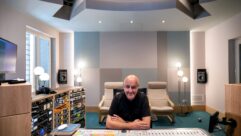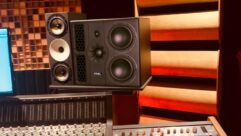
Acoustic Transmission
Jun 26, 2014 11:14 AM, By Bob McCarthy
Moving sound from point A to B

Figure 1: Inverse square law: The standard transmission loss rate for sound in air (free field conditions).See larger image
Transmission is the movement of signals from senders to receivers. For acoustic transmission, the senders are musical instruments, voices, loudspeakers—anything that makes noise. The receivers are ears and microphones. Propagation through air is complex. It is noticeably frequency-dependent, begins in unique shapes, goes in all directions, bends around things, and changes with the weather. Traveling through a wire, by contrast is indoor living at its finest.
Ready to get theoretical? An infinitely small sound source will propagate spherically as an ideal point source. Sound propagates equally outward in all directions (omnidirectionality) and will exhibit an SPL loss rate of 6dB for every doubling of distance. Last week, we loaded our infinitely small speakers into the truck but nobody could find them when we got to the gig.
Waves and Sources
All sound sources have size and therefore are not ideal point sources. We can still start from the ideal single sound source propagating spherical waves and losing approximately 6dB per/doubling of distance. The directional propagation pattern will be subject to a host of steering options but for now, let’s suffice to say that once we get far enough away from the source, it will propagate with a constant directional pattern over distance.
Planar waves are an acoustic wavefront created when the source is stretched over an area. This is found at the mouth of a horn, where the wavefront has been shaped by its expanding taper. The loss rate and directionality diverge greatly from the spherical radiation model inside the area where planar radiation occurs. Propagation reverts to spherical after exiting the horn mouth. The horn’s directional imprint is maintained, but the loss rate reverts to 6dB/doubling.
Consider another theoretical construct: the infinite line source, an array of closely spaced sources of infinite length. Whereas the planar wave stretches its width in two dimensions, the infinite line source stretches in just one. In theory we can reduce the loss rate to 3dB/doubling. In practice it takes infinity to unload the truck. A finite line source creates reduced loss propagation for a finite distance, and then it reverts to the spherical propagation model of 6dB/ doubling. We see spherical propagation unless we are in the near field of an array or have our head in a horn.
Speed
The speed of sound in air formula is 331.4 + 0.607 x temperature (°C) in meters/second. This yields 344.75 meters/second at 22°C. Wrapping our brains around this is difficult because the parameters are so out of scale. Imagine a speedometer that reads kilometers per week. 334.75 meters is too big to visualize and one-second time increments are laughably imprecise.
Let’s invert and convert this to milliseconds/meter instead. That’s 2.94 milliseconds/meter (at 22°C), which can be rounded to 3 milliseconds/meter. There are three options for English system users: (1) Learn the metric system, (2) milliseconds/foot, which rounds to 0.9 milliseconds/foot and, (3) feet/milliseconds, which rounds to 1.1ft./milliseconds. I cannot emphasize enough the advantage of visualizing distance in milliseconds, since this unit is required for understanding phase and frequency, speaker interaction and reflections.
Upper and Lower Limits
An acoustic source (or loudspeaker) propagates sound into a very low impedance medium: air. The ear (or microphone) senses the propagating waveform without sucking all the air out of the room. In short, lots of power is required to push the waveform through the medium, but not to sense its presence.
At extremely high levels (>150dB SPL), the air medium becomes increasingly non-linear and hits a hard limit at 194dB SPL peak (equivalent to one atmosphere). On the rarefaction side (low pressure) we have literally run out of air. There are physical limits to the medium, not just our ears, so the quest for infinite SPL ends at 194dB SPL peak. Compression chambers and horn throats are among the most likely places where acoustic medium distortion will occur.
The lower limit is Brownian noise, which is around the same loudness as our threshold of hearing (0dB SPL). Nothing in nature actually sits still, and air molecules are no exception. Brownian motion is statistically random and therefore creates white (not brown) noise.
Acoustic Transmission
Jun 26, 2014 11:14 AM, By Bob McCarthy
Moving sound from point A to B

Figure 2: Loss rate and directionality: The transmission loss rate is not changed by source directivity.See larger image
Loss Rate (Inverse Square Law)
The inverse square law is the common name for the 6dB/doubling loss rate of spherical wave propagation. This hypothetical standard rate (the “free field” response) requires special conditions that can never quite be met, but nonetheless, are the best starting reference for mapping out level over distance. Air is a lossy medium in the HF range, which falls at an accelerated rate. Reflected energy adds to the direct sound, which (mostly) reduces the loss rate. Coupled speaker arrays (sources close together) can decrease the loss rate (as a combination), but only in the near field. Inverse square is not just a good idea. It’s the law. It doesn’t discriminate between loudspeakers, musical instruments, and humans.
A trend is seen as we move away from a typical source (more HF directionality than LF). The HF region will maintain free field behavior for a longer distance than the LF. Low frequencies go rogue first because their wide coverage quickly gets the floor, ceiling, and walls involved, reducing the loss rate. The HF has three advantages that keep it in the free field zone for longer: more directionality in the source, higher loss rate in the air, and more absorption on the surfaces.
In summary: Air loss accelerates the loss rate linearly with distance. Reflections decelerate the loss rate minimally in the near field and increasingly in the far field. Speaker arrays decelerate the loss rate maximally in the near field and minimally in the far field.
As we walk away from a sound source the frequency response will change, since the highs will drop at closer to the free field rate than the lows. This is true of loudspeakers and natural sources.
Coverage pattern
Does coverage pattern affect the inverse square law? Does an omnidirectional device drop off at a different rate than a directional one? The answer is a slightly qualified “no.” Once we are far enough away for the source’s coverage pattern to fully stabilize, the drop-off rate follows the inverse square law rules. If it’s 10dB louder in front at 1 meter, it will hold that relationship at further distances. Spherical wave propagation is an equal opportunity pressure dropper.
How do we know when we are far enough to have a stable loss over distance over angle? This is a case where size matters. A tiny point source like a clicker will reach maturity at close range. A giant Japanese Taiko drum needs some space. Spread sources (e.g., a piano) or those with multiple acoustic outputs (e.g., bagpipes) also add complexity. A typical two-way speaker is both spread and has multiple outputs. A 5-meter-tall stack of speakers will need lots of room to finish adding up the elements.
Humidity effects
Air is a highly imperfect transmission medium, and adding weather to the equation does nothing to make our lives easier. The dynamic nature of air leads to changes in frequency response, sound speed, and directional pattern.
The air medium’s accelerated HF loss rate generally tracks with humidity. Dry air is lossy air. Unless we are doing outdoor concerts in January in Oslo, we will find a simple relationship between humidity and HF loss, without the need to consider temperature. The frequency response effects are like a low-pass filter. The filter slope rises as humidity falls and the corner frequency falls as transmission length increases. Humidity effects on the HF response are easy to hear, and easy to act on. They affect only the very top end so a broad HF boost or cut can return things back to normal.
Acoustic Transmission
Jun 26, 2014 11:14 AM, By Bob McCarthy
Moving sound from point A to B

Figure 3: Humidity and temperature effects: The standard transmission loss rate is affected by changes in humidity and temperature. See larger image
Temperature effects
Temperature change affects sound speed. Hot air is fast air. We can’t see the “normal” sound speed, which makes it difficult to sense such a change in the direct sound arrival from a single source. Sound is always behind light, so even natural audio is out of sync to the visual. The question is simply how much. When multiple paths of different lengths are involved, a change in temperature moves into audibility because the summation is modified by the speed change. Reflections and delay speakers are examples of this.
How much does the sound speed change over temperature? Not much. If we did a concert that went from a sauna to ice cold, the sound speed would have fallen by 10 percent. It takes a rise of 10°F to increase the sound speed by a mere one percent (a 100 millisecond path would now become a 99 millisecond path).
Temperature change adjusts sound speed by a given percentage. Therefore longer paths change more than short ones. As temperature rises the transit time between a main speaker and a delay shrinks and the sound gets to the walls and back again faster than before. The wavelength of sound is rescaling with temperature. This is hard to visualize, since sound is invisible. Instead we can do a reality polarity reversal and visualize temperature as rescaling our drawings of the room, with wavelengths staying the same. Either way, the reality is that a hot room fits fewer wavelengths of a given frequency. The longest paths have the most accumulated change over temperature. The longest audible paths indoors are LF reflections, which is the range we are most likely to find detectible changes related to temperature.
How much will temperature change modify the acoustic response? Not enough to fix a bad sound design or break a good one. One immediate concern is the settings on delay speakers. A quick math exercise will put this in perspective.
An example main/delay combination has respective paths of 100 milliseconds and 20 milliseconds. Let’s sync them with 80 milliseconds of delay (100 milliseconds to 20 milliseconds). It’s perfect for one seat and then time-offset errors begin from there. Sad, but true. Later the temperature rises by 20° F, a big temperature change that accelerates the speed by 2 percent. The new paths are 98 milliseconds and 19.6 milliseconds, respectively, which yields an offset of 78.4 milliseconds, an error of 1.6 milliseconds. How bad is that? The location of precise synchronicity might have moved one seat.
Temperature effects on reflections are similar, but multiplied tremendously in quantity. All direct and reflected sound paths accelerate as a room warms up. Let’s do a similar exercise. We’ll use those same numbers for the direct sound (20 milliseconds) and reflection path (100 milliseconds) so the time offset is 80 milliseconds. This creates a comb filter frequency of 12.5Hz (peaks at 25Hz, 37.5Hz, 50Hz, and so on). The same 2 percent temperature shift changes the time offset again to 78.4 milliseconds. Now the comb filter frequency is 12.75Hz (peaks at 25.5 Hz, 38.26 Hz, 51 Hz). Not exactly a game changer, eh?
The paths must be extremely long to be worth monitoring for delay speakers and many long reflection paths for us to hear the sound change solely because of temperature.
Wind effects
Sound is moving through air. Wind is moving air. Sound moving through moving air is a mess. There is no simplistic way to describe any particular moment of the wind’s effects, but we can explore the principal mechanisms. Standard sound speed is 767mph. Gale force winds begin in the 32 to 38mph range, which could add or subtract 10 percent to the speed of sound if the wind is traveling in the same direction as the sound. Wind going in the direction of the sound is simple to visualize, while a crosswind is less so. All of this is blown out the window when we remember that sound transmits spherically through the air, which is impossible for wind. If wind moved spherically away from a location it would leave a vacuum. Wind moves in a direction and air is pulled in behind it to fill the lower pressure. Since sound propagates spherically we will have every relationship possible to the wind direction, all the time. Our sound waves are moving with, against, and across the wind.
The concert with the gale force winds was cancelled, so let’s consider a moderate breeze (13-18mph). Now we have a ±2-3-percent change in sound speed, in the range we find with changing temperature. The effect is not uniform over the space, even if the breeze were rock-steady, because of the propagation issue. Let’s run through some possibilities of one path: the one to our ears.
A baseball pitcher throws straight (fastballs) and curve balls. For the fastball he aims at the target and sends it. For the curve ball he aims somewhere else, knowing that the path will have a bend in it. A third pitch is the changeup, an unexpectedly slow pitch. A speaker in still air throws fastballs, a straight line from speaker to listener. If there is wind our speaker starts throwing the tricky stuff. A headwind slows it like a changeup. A crosswind causes our sound path to bend like a curveball. The sound that we hear was actually aimed somewhere else and bent in our direction. Our sound went to our neighbor. That wouldn’t matter if the wind was constant, but it never is, so we get a variety pack of sound aimed at others arriving at our location. It sounds as if somebody is wiggling our speaker. There is a small amount of pitch shifting due to the Doppler Effect. If the source has a uniform directional response then there will be a minimal change in frequency response.
Speaker arrays have a fine grain of amplitude and phase interactions between the elements. These are measurable in the best of times, and audibly degrading in the worst. Our brains do a remarkable job of adapting to stable combing effects. Shifting comb filter interaction (flanging) is profoundly audible. Bending the paths from an array puts the fine-grained flanging in motion at our location, and differently at everyone else’s.
We can encounter two types of wind in indoor spaces. HVAC blowers are indistinguishable from a steady breeze of outdoor wind (modulating phase response, moving impulse response and decreased coherence in the HF). The second is moving speakers, such as a newly hung cluster that is still swinging. It’s not really wind, of course, but it walks likes a wind and talks like a wind, and we can hear it. Outdoors, the wind may actually be moving the speakers, in which case the solution is to secure the speakers (for safety, not sound quality).
We discussed wind-induced bending and temperature effects on sound speed. These can come together in long-distance applications to create a larger scale form of bending, similar to the way light bends through the air. It is a form of refraction that results from layers of air at different temperatures (termed thermal gradients). Consider the distant train horn that some nights is faint and other nights feels close by. The refraction on one night bends it down to us and on others sends it skyward. Large-scale outdoor concerts can sometimes encounter mysterious disappearances of their sound and extremely disturbing landings into unhappy neighborhoods.










